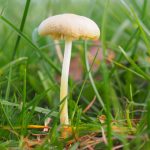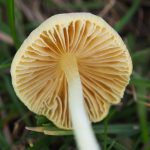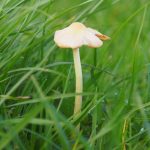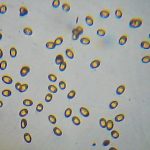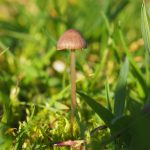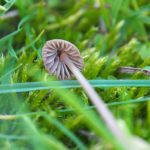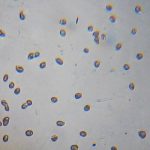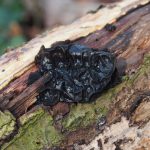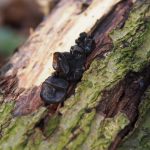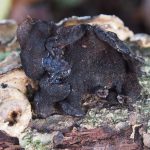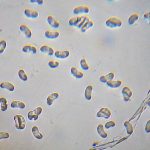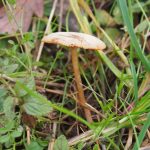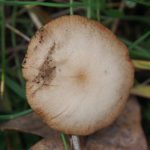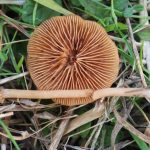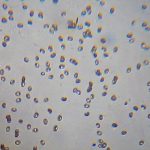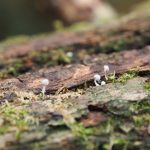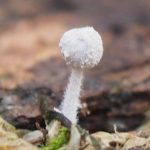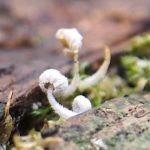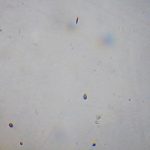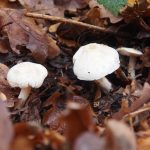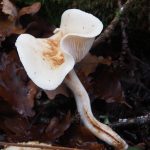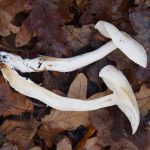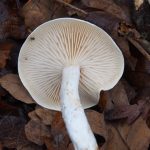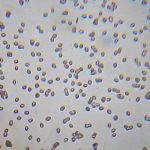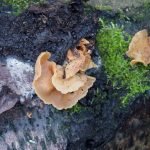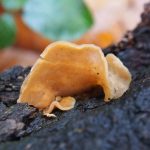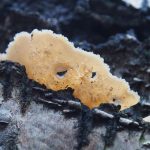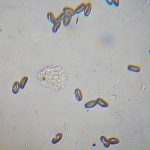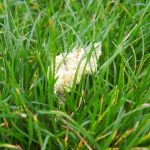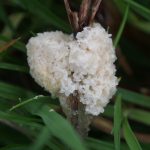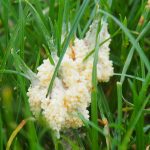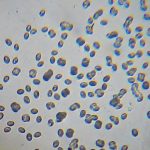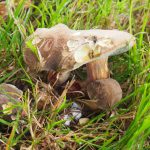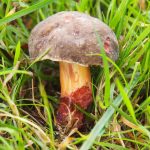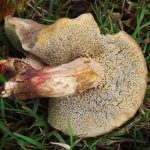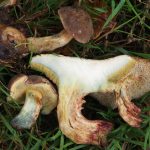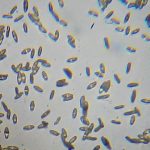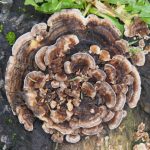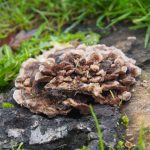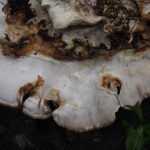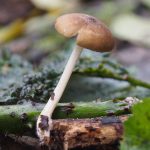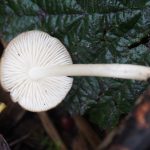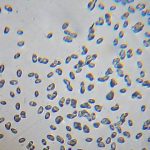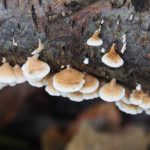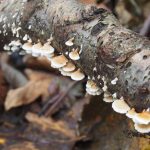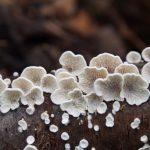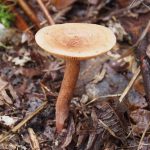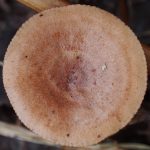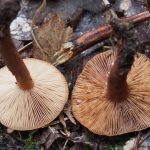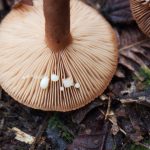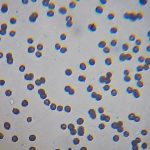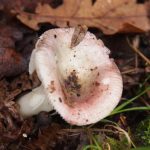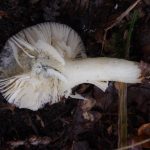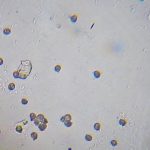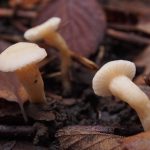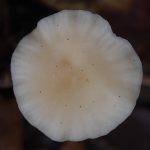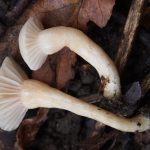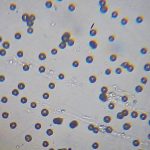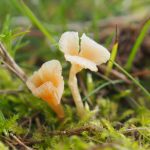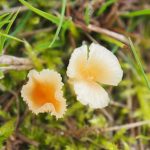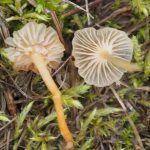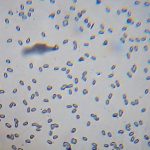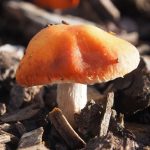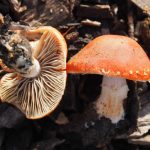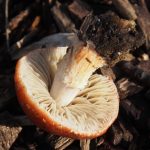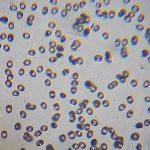Went back to Oxleas but there wasn’t a great deal to see, maybe mid-November is getting a bit too late in the season.
A few highlights: Glad to see lots of Yellow Fieldcaps in the meadow, it’s nice to find a place where a species is abundant. Witches’ Butter is a new find for me. My book says this is thought to be common but very seldom recorded. Conocybe pilosella is new for me as well, though to be honest the id is very shaky. There’s lots of similar looking Conocybes and similar genera. The unidentified tiny, tiny mushroom (no.5 below) was a very exciting find, with a cap around 1mm across! The mycena genera contains many very small species but none of my books or any online resources mention anything with a proper mushroom shape and a 1mm cap, as far as I can see. Frosty Bonnet is pretty damn small but my beauties are significantly smaller than that! Pedicel Cup is one of many similar fungus species with a cup shape and fawn or brown colour – over 100 apparently, so can’t be sure of any identification. Don’t remember ever seeing one like this on a birch log before and Pedicel Cup is commonly found on beech and elm. And lastly, Dog Vomit Slime Mould… I love finding slime mould – it’s a fascinating organism. I don’t find it very often. I expect there’s lots of it around but it just doesn’t gather into bodies very often. Also known as scrambled egg slime, or flowers of tan, and in Scandinavian folklore as troll cat vomit! Is it climbing the grass stems in order to hitch a ride or to spread its spores in the wind better?
Monthly Archives: November 2020
1. Yellow Fieldcap (Bolbitius titubans).
- 1. Yellow Fieldcap
- 1. Yellow Fieldcap
- 1. Yellow Fieldcap
- 1. Yellow Fieldcap
2. Unidentified.
- 2. Unidentified
- 2. Unidentified
- 2. Unidentified
3. Witches' Butter (Exidia glandulosa).
- 3. Witches' Butter
- 3. Witches' Butter
- 3. Witches' Butter
- 3. Witches' Butter
4. Conocybe pilosella.
- 4. Conocybe pilosella
- 4. Conocybe pilosella
- 4. Conocybe pilosella
- 4. Conocybe pilosella
5. Unidentified.
- 5. Unidentified
- 5. Unidentified
- 5. Unidentified
- 5. Unidentified
6. Spotted Toughshank (Collybia maculata).
- 6. Spotted Toughshank
- 6. Spotted Toughshank
- 6. Spotted Toughshank
- 6. Spotted Toughshank
- 6. Spotted Toughshank
7. Pedicel Cup (Peziza micropus).
- 7. Pedicel Cup
- 7. Pedicel Cup
- 7. Pedicel Cup
- 7. Pedicel Cup
8. Dog Vomit Slime Mould (Fuligo septica).
- 8. Dog Vomit Slime Mould
- 8. Dog Vomit Slime Mould
- 8. Dog Vomit Slime Mould
- 8. Dog Vomit Slime Mould
6th November 2020, Beckenham Place Park
It is the fate of mushroom hunters to sometimes encounter things that they cannot identify, despite making every possible effort. Although I have many mushroom identification books, the one I use most is the Collins Fungi Guide (Buczacki) simply because it lists more species than any others, over 2400. But of course, it isn’t complete and doesn’t include many rare ones and foreign invaders. On this foray I found two specimens that I don’t recognise and can’t find in any of my books. One is a small innocuous looking single specimen growing from the end of a twig. It looks like Hydropus floccipes (which I’ve never encountered) but the spore shape is wrong. That has spherical spores whereas mine are elliptical or slightly bean shaped. I can’t find any other species with the right characteristics. The other species that I can’t identify is a small, nearly pure white one with a waxy look, growing in woodland. There’s quite a few mushrooms like that but none that I can find with spherical spiny spores. The main groups that have such spores are Brittlegill (Russula), Milkcap (Lactarius) and Deceiver (Laccaria). It’s nothing like the first two but does have the general appearance of a Deceiver, except that none of those are white.
Mycena mirata is another small Bonnet mushroom but new to me. The Suede Boletes were growing in a cluster which is very unusual for Boletes. Turkeytail is maybe the most common fungus in the country but this was an attractive rosette. Plicatura crispa is a very interesting find. This species has been confined to Scotland and the north but is apparently travelling southwards. Online I found just one record in the south, from East Susses and it’s definitely this species, as the underside with forked folds is unmistakable. Oakbug Milkcap is very common and I see it often. Pelargonium Brittlegill is a rather speculative identification as I only found one specimen and didn’t pay enough attention to details such as taste and how much the cap will peel. But it’s a nice pinkish little thing! Orange Mosscap I also see often. Redlead Roundhead is a striking orange mushroom that I haven’t seen before. It’s thought to have come from abroad and now is becoming more common in woodchip mulch environments like this.
1. Mycena mirata.
- 1. Mycena mirata
- 1. Mycena mirata
- 1. Mycena mirata
2. Suede Bolete (Boletus subtomentosus).
- 2. Suede Bolete
- 2. Suede Bolete
- 2. Suede Bolete
- 2. Suede Bolete
- 2. Suede Bolete
3. Turkeytail (Trametes versicolor).
- 3. Turkeytail
- 3. Turkeytail
- 3. Turkeytail
4. Unidentified.
- 4. Unidentified
- 4. Unidentified
- 4. Unidentified
5. Plicatura crispa.
- 5. Plicatura crispa
- 5. Plicatura crispa
- 5. Plicatura crispa
6. Oakbug Milkcap (Lactarius quietus).
- 6. Oakbug Milkcap
- 6. Oakbug Milkcap
- 6. Oakbug Milkcap
- 6. Oakbug Milkcap
- 6. Oakbug Milkcap
7. Pelargonium Brittlegill (Russula pelargonia).
- 7. Pelargonium Brittlegill
- 7. Pelargonium Brittlegill
- 7. Pelargonium Brittlegill
8. Unidentified.
- 8. Unidentified
- 8. Unidentified
- 8. Unidentified
- 8. Unidentified
9. Orange Mosscap (Rickenella fibula).
- 9. Orange Mosscap
- 9. Orange Mosscap
- 9. Orange Mosscap
- 9. Orange Mosscap
10. Redlead Roundhead (Leratiomyces ceres).
- 10. Redlead Roundhead
- 10. Redlead Roundhead
- 10. Redlead Roundhead
- 10. Redlead Roundhead

